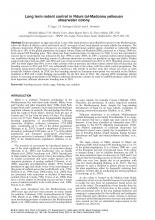Criteria to help evaluate and guide attempts to eradicate terrestrial arthropod pests


Island and Ocean Ecosystems, BRB
Available Online
Broome, K.
,
Brown, K.
,
Green, C.
,
Phillips, C.B.
,
Walker, G.
2019
Attempts to eradicate invasive terrestrial arthropods are often regarded as gambles. They o?er the possibility of long term freedom from a pest but are usually confronted with substantial uncertainty and come with a range of technical, economic, environmental, social and political risks. Few guidelines are available for evaluating eradication attempts against terrestrial arthropods. Here, we build on scienti?c literature, including six criteria previously developed to evaluate the feasibility of vertebrate eradications, and our own experiences to de?ne nine criteria that are intended to both assist experts to evaluate proposed arthropod eradication attempts and guide attempts that are underway. The criteria are straight forward and easily interpreted, though evaluating them for a particular programme relies on expert group assessment that will often benefit from rigorous supporting statistical and/or modelling analyses.






